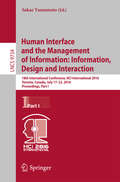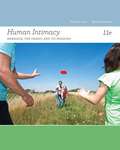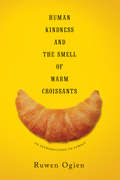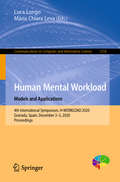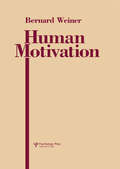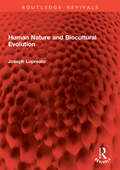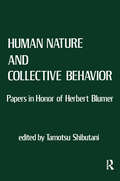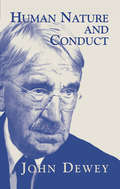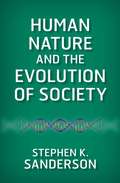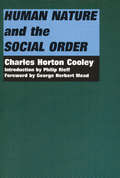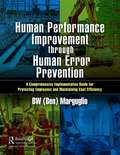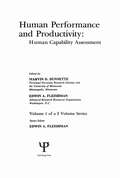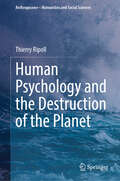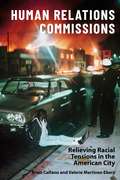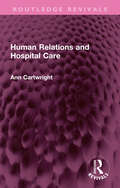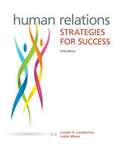- Table View
- List View
Human Interface and the Management of Information: Thematic Area, HIMI 2025, Held as Part of the 27th HCI International Conference, HCII 2025, Gothenburg, Sweden, June 22–27, 2025, Proceedings, Part III (Lecture Notes in Computer Science #15775)
by Hirohiko Mori Yumi AsahiThe three-volume set LNCS 15773 - 15775 constitutes the thoroughly refereed proceedings of the thematic area Human Interface and the Management of Information, HIMI 2025, held as part of the 27th International Conference on Human-Computer Interaction, HCI International 2025 (HCII 2025), which was held in Gothenburg, Sweden, during June 22–27, 2025. The total of 1430 papers and 355 posters included in the HCII 2025 proceedings was carefully reviewed and selected from 7972 submissions. The papers in these proceedings have been organized in topical sections as follows: Part I: Information design and visualization; human-human and human-AI collaboration; user experience design and evaluation; Part II: Information in eHealth; information, knowledge and learning; Part III: Multimodality and information; eCommerce and industrial applications.
Human Interface and the Management of Information:Information, Design and Interaction
by Sakae YamamotoThe three-volume set LNCS 8016, 8017, and 8018 constitutes the refereed proceedings of the 15th International Conference on Human-Computer Interaction, HCII 2013, held in Las Vegas, NV, USA in July 2013. The total of 1666 papers and 303 posters presented at the HCII 2013 conferences was carefully reviewed and selected from 5210 submissions. These papers address the latest research and development efforts and highlight the human aspects of design and use of computing systems. The papers accepted for presentation thoroughly cover the entire field of human-computer Interaction, addressing major advances in knowledge and effective use of computers in a variety of application areas. This volume contains papers in the thematic area of human interface and the management of Information, addressing the following major topics: interacting with information, information searching, browsing and structuring, design and development methods and tools for interactive systems and services, personalized information and interaction, cognitive and emotional aspects of interacting with information.
Human Intimacy (Eleventh Edition): Marriage, The Family, And Its Meaning
by Frank D. Cox Kevin DemmittOffering a positive view of the family, Cox's HUMAN INTIMACY: MARRIAGE, THE FAMILY, AND ITS MEANING, Eleventh Edition discusses the characteristics of successful intimate relationships, and teaches the decision-making skills that lead to strong marriages and families. You'll find coverage of such topics as diversity within the American family (including rural and military families), gay marriage, singles, cohabitation, gender roles, theories of love, date rape and courtship violence, and parenting and life stages.
Human Judgment: How Accurate Is It, and How Can It Get Better? (SpringerBriefs in Psychology)
by John WilcoxWe humans make judgments about a staggering variety of topics. These include which medical condition is the correct diagnosis for your symptoms, whether a particular defendant is guilty of some crime or whether a particular political candidate will win an election—to name a few of countless examples. But how accurate are the judgments we all make, and how can they get better? This book synthesizes interdisciplinary research about these questions into one volume. In doing so, it uniquely draws on insights from fields as diverse as medicine, political judgment, cross-cultural psychology, evolutionary history and the heuristics and biases research program. Consequently, the book also enables readers concerned with judgmental accuracy in one field to benefit from the insights in others. Moreover, the author introduces an emerging field of research: empirical epistemology or normative cognitive science. The book lastly articulates a set of recommendations—recommendations aiming to improve our judgment, our decision-making and ultimately our lives.
Human Kindness and the Smell of Warm Croissants: An Introduction to Ethics
by Ruwen OgienHuman Kindness and the Smell of Warm Croissants makes philosophy fun, tactile, and popular. Moral thinking is simple, Ruwen Ogien argues, and as inherent as the senses. In our daily experiences, in the situations we confront and in the scenes we witness, we develop an understanding of right and wrong as sophisticated as the moral outlook of the world's most gifted philosophers. By drawing on this knowledge to navigate life's most perplexing problems, ethics becomes second nature.Ogien explores, through experimental philosophy and other methods, the responses nineteen real-world conundrums provoke. Is a short, mediocre life better than no life at all? Is it acceptable to kill a healthy person so his organs can save five others? Would you swap a "natural" life filled with frustration, disappointment, and partial success for a world in which all of your needs are met, but through artificial and mechanical means? Ogien doesn't seek to show how difficult it is to determine right from wrong or how easy it is for humans to become monsters or react like saints. Helping us tap into the wisdom and feeling we already possess in our ethical "toolboxes," Ogien instead encourages readers to question moral presuppositions and rules; embrace an intuitive sense of dignity, virtue, and justice; and pursue a pluralist ethics suited to the principles of human kindness.
Human Memory: Second Edition
by Gabriel A. RadvanskyProvides students with a guide to human memory, its properties, theories about how it works, and how studying it can help us understand who we are and why we do the things that we do. For undergraduate and graduate courses in Human Memory. This book provides a very broad range of topics covering more territory than most books. In addition to some coverage of basic issues of human memory and cognition that are of interest to researchers in the field, the chapters also cover issues that will be relevant to students with a range of interests including those students interested in clinical, social, and developmental psychology, as well as those planning on going on to medical and law schools. The writing is aimed at talking directly to students (as opposed to talking down to them) in a clear and effective manner. Not too dense, but also not too conversational as well. This 2nd edition includes a series of exercises that allow the student to try out the concepts and principles conveyed in the chapters, or to use as the basis for exploring their own ideas.
Human Mental Workload: 4th International Symposium, H-WORKLOAD 2020, Granada, Spain, December 3–5, 2020, Proceedings (Communications in Computer and Information Science #1318)
by Luca Longo Maria Chiara LevaThis book constitutes the refereed proceedings of the 4th International Symposium on Human Mental Workload: Models and Applications, H-WORKLOAD 2020, held in Granda, Spain*, in December 2020.The volume presents one keynote paper as well as 13 revised full papers, which were carefully reviewed and selected from 22 submissions. The papers are organized in two topical sections on models and applications.*The conference was held virtually due to the COVID-19 pandemic.
Human Motivation (Sixth Edition)
by Robert E. FrankenThis Sixth Edition provides a thorough introduction to the basic facts and major theories of human motivation. Throughout the book, the author addresses the types of questions that often arise, such as "Why are some people more organized than others?" and "Why do people dream?" In his exploration of day-to-day human motivation, Franken provides a topical organization that shows students how biology, learning, and cognition interact with individual differences to produce human behavior.
Human Motivation: Metaphors, Theories, And Research
by Bernard WeinerWeiner introduces -- and offers his own motivation for producing - - this most impressive work with the following: There are two distinct approaches to the study of motivation. One stratagem is a product of academic, experimental procedures, while the second is an outgrowth of clinical, non-experimental methods. Each of the approaches has unique advantages and disadvantages. But all investigators in this field are guided by a single basic question, namely, "Why do organisms think and behave as they do?" To help answer that basic question, Human Motivation presents an entire range of motivation studies -- from psychoanalytic, social learning and humanistic theory; to social facilitation, arousal, emotions, personal responsibility, and the irrationality of attributions; through chapterand verse of Hullian and Lewinian theory.
Human Nature and Biocultural Evolution (Routledge Revivals)
by Joseph LopreatoFirst published in 1984, Human Nature and Biocultural Evolution aims to delineate a theory of human nature, viewed as an interrelated set of genetically programmed behavioral predispositions, and a theory of biocultural evolution. The author’s approach is based on the hypothesis that innate predispositions and cultural-environmental factors cooperate to determine human behavior and socio-cultural forms.Professor Lopreato begins by tracing the development of evolutionary biology up to sociobiology. It is his argument that the social and biological disciplines have, for over a century, been moving towards a synthesis, and that Homo sapiens is neither just another animal, nor so unique a being that culture has become divorced from its genetic underpinnings. The argument is supported with evidence from evolutionary biology and social science, with a critical discussion of basic issues of behavioral science and with an analysis of certain famous theories in social science (e.g. theories of suicide, anomie, capitalism), which prove to be richer and more complete when viewed from a biocultural perspective.The theory of human nature is arrived at through a rich analysis of ethnographic, psychological, and sociological arguments and data, as well as facts and theories from comparative zoology. In the process, the author treats critically numerous theoretical problems associated with topics such as exploitation, class consciousness, structured inequality, reciprocal behavior, territorial aggression, religious ritual, socialization, ethnicity, and prejudice. The author concludes with an examination of behavioral predispositions that are hypothesized to be at the base of cultural variation.
Human Nature and Collective Behavior: Papers in Honor of Herbert Blumer
by Tamotsu ShibutaniTamotsu Shibutani is professor of sociology at the University of California, Santa Barbara. He is the author of Social Processes: An Introduction to Sociology and Improvised News: A Sociological Study of Rumor.
Human Nature and Conduct
by John DeweyA morality "based on the study of human nature instead of upon disregard for it" is the focus of this influential work by one of America's greatest educators and philosophers. John Dewey maintains that the key to social psychology lies in an understanding of the many varieties of habit; individual mental activity, on the other hand, is guided by the subordinate factors of impulse and intelligence."The mind," Dewey asserts, "can be understood in the concrete only as a system of beliefs, desires, and purposes which are formed in the interaction of biological aptitudes with a social environment." His investigation focuses on three main areas: the place of habit in conduct; the place of impulse in conduct; and the place of intelligence in conduct. Each factor receives an incisive treatment, brimming with ideas, insights, and considered reflections.This classic of its genre presents a rich banquet of food for thought, certain to be appreciated by educators, psychologists, philosophers, and anyone interested in the role of the individual in society.
Human Nature and the Evolution of Society
by Stephen K. SandersonIf evolution has changed humans physically, has it also affected human behavior? Drawing on evolutionary psychology, sociobiology, and human behavioral ecology, Human Nature and the Evolution of Society explores the evolutionary dynamics underlying social life. In this introduction to human behavior and the organization of social life, Stephen K. Sanderson discusses traditional subjects like mating behavior, kinship, parenthood, status-seeking, and violence, as well as important topics seldom included in books of this type, especially gender, economies, politics, foodways, race and ethnicity, and the arts. Examples and research on a wide range of human societies, both industrial and nonindustrial, are integrated throughout. With chapter summaries of key points, thoughtful discussion questions, and important terms defined within the text, the result is a broad-ranging and comprehensive consideration of human society, thoroughly grounded in an evolutionary perspective.
Human Nature and the Evolution of Society
by Stephen K. SandersonIf evolution has changed humans physically, has it also affected human behavior? Drawing on evolutionary psychology, sociobiology, and human behavioral ecology, Human Nature and the Evolution of Society explores the evolutionary dynamics underlying social life. In this introduction to human behavior and the organization of social life, Stephen K. Sanderson discusses traditional subjects like mating behavior, kinship, parenthood, status-seeking, and violence, as well as important topics seldom included in books of this type, especially gender, economies, politics, foodways, race and ethnicity, and the arts. Examples and research on a wide range of human societies, both industrial and nonindustrial, are integrated throughout. With chapter summaries of key points, thoughtful discussion questions, and important terms defined within the text, the result is a broad-ranging and comprehensive consideration of human society, thoroughly grounded in an evolutionary perspective.
Human Nature and the Social Order
by Charles Horton CooleyThis work remains a pioneer sociological treatise on American culture. By understanding the individual not as the product of society but as its mirror image, Cooley concludes that the social order cannot be imposed from outside human nature but that it arises from the self. Cooley stimulated pedagogical inquiry into the dynamics of society with the publication of Human Nature and the Social Order in 1902. Human Nature and the Social Order is something more than an admirable ethical treatise. It is also a classic work on the process of social communication as the "very stuff" of which the self is made.
Human Perception
by Marco Bertamini Michael KubovyIt takes little or no effort for us to gather information by means of our senses but it would be a mistake to take this as a sign that perception is simple. It was in the 20th century and after the establishment of psychology as a scientific discipline that the study of perception flourished. This important volume gathers together a selection of articles and essays which represent some of the most interesting discoveries and theories. It gives a flavour of the many different approaches and ideas taken by cognitive psychologists in this fascinating area. Topics covered include: attention, brain systems, object interpolation and completion, object recognition and classification, different types of objects, and information processing and models.
Human Performance Improvement through Human Error Prevention: A Comprehensive Implementation Guide for Protecting Employees and Maintaining Cost Efficiency
by BW (Ben) MarguglioThis book is a simulation of a live course on human performance improvement/human error prevention (HPI/HEP) created by the preeminent authority on HPI/HEP. It presents the greatest breadth of scope and specificity on this topic. This book comprises a focused, challenging human error prevention training course designed to improve understanding of error causation. It will dramatically reduce human error and repeat deviations, and it digs below the surface of issues and looks to fix the real causes of human error and mistakes. In addition, this book presents a complete seminar from the thought leader acclaimed by hundreds of clients, and includes unique principles, practices, models, and templates. Information is comprehensive and can be directly implemented. The principles and practices of human error prevention are universally applicable regardless of the type of industrial, commercial, or governmental enterprise, and regardless of the type of function performed within the enterprise. The application of the information in this book will significantly contribute to improved productivity, safety, and quality. After fully using this book, you will understand: Human error prevention/reduction terminology and definitions. The relationships among culture, beliefs, values, attitudes, behavior, results, and performance. The roles of leadership in establishing and maintaining a quality/safety-conscious work environment. The one fundamental precept explaining the importance of human error prevention/reduction. The two most critical elements of human error prevention/reduction. The three levels of barriers to human error. The four types of things in which the barriers may exist at each barrier level. The five stages of human error. The six "M"s that can emit or receive hazards activated by human error. The seven universally applicable human error causal factors. The Rule of 8 by which to prevent human error and mitigate its effects. Techniques for making barriers effective and the spectrum of barrier effectiveness. The relationship of human error prevention/reduction to the total quality/safety function. Error-inducing conditions (error traps) and behaviors for counteracting these conditions. Non-conservative and conservative thought processes and behaviors in decision-making. Coaching for preventing the recurrence of human error. Root cause analysis techniques for identifying human error causal factors. The nine types of corrective action. Human error measurement. Strategies for a human error prevention/reduction initiative. How to design, implement, and manage a human error prevention/reduction initiative.
Human Performance Improvement through Human Error Prevention: A Comprehensive Implementation Guide for Protecting Employees and Maintaining Cost Efficiency
by BW (Ben) MarguglioThis book is a simulation of a live course on human performance improvement/human error prevention (HPI/HEP) created by the preeminent authority on HPI/HEP. It presents the greatest breadth of scope and specificity on this topic. This book comprises a focused, challenging human error prevention training course designed to improve understanding of error causation. It will dramatically reduce human error and repeat deviations, and it digs below the surface of issues and looks to fix the real causes of human error and mistakes. In addition, this book presents a complete seminar from the thought leader acclaimed by hundreds of clients, and includes unique principles, practices, models, and templates. Information is comprehensive and can be directly implemented. The principles and practices of human error prevention are universally applicable regardless of the type of industrial, commercial, or governmental enterprise, and regardless of the type of function performed within the enterprise. The application of the information in this book will significantly contribute to improved productivity, safety, and quality. After fully using this book, you will understand: Human error prevention/reduction terminology and definitions. The relationships among culture, beliefs, values, attitudes, behavior, results, and performance. The roles of leadership in establishing and maintaining a quality/safety-conscious work environment. The one fundamental precept explaining the importance of human error prevention/reduction. The two most critical elements of human error prevention/reduction. The three levels of barriers to human error. The four types of things in which the barriers may exist at each barrier level. The five stages of human error. The six "M"s that can emit or receive hazards activated by human error. The seven universally applicable human error causal factors. The Rule of 8 by which to prevent human error and mitigate its effects. Techniques for making barriers effective and the spectrum of barrier effectiveness. The relationship of human error prevention/reduction to the total quality/safety function. Error-inducing conditions (error traps) and behaviors for counteracting these conditions. Non-conservative and conservative thought processes and behaviors in decision-making. Coaching for preventing the recurrence of human error. Root cause analysis techniques for identifying human error causal factors. The nine types of corrective action. Human error measurement. Strategies for a human error prevention/reduction initiative. How to design, implement, and manage a human error prevention/reduction initiative.
Human Performance and Productivity: Volumes 1, 2, and 3
by Marvin D. Dunnette Edwin A. FleishmanThese volumes represent a concerted attempt to link what is known from human performance research to recognized national needs for improving productivity. The product of a National Science Foundation project directed by the series editor, the set features authoritative reviews by leading psychologists in the field. The volumes cover many areas of human performance not included in other books.
Human Psychology and the Destruction of the Planet (Anthropocene – Humanities and Social Sciences)
by Thierry RipollThis book sheds light on the reasons for our inaction in matters of the environmental crisis and presents solutions to address the crisis. The work draws on numerous disciplinary fields, such as psychology, neuroscience, anthropology, biology, philosophy, sociology, economics, ethology. The author argues that it is not possible to correctly understand the current environmental crisis in the light of a single discipline and emphasizes the importance of cognitive sciences to address the environmental crisis. He shows that the reasons for human inaction relate as much to the characteristics of our psyche/brain as to those of the consumption society that we invented and have lived in at least since the Neolithic. The analysis presented stresses the need to regulate individual behavior and to call into question our consumption patterns. Without questioning the characteristics of both modern society, and the way our brains work, will make it impossible to resolve the environmental crisis. This book proposes a revolutionary change of the way we live and act to preserve the planet.
Human Recognition at a Distance in Video
by Bir Bhanu Ju HanMost biometric systems employed for human recognition require physical contact with, or close proximity to, a cooperative subject. Far more challenging is the ability to reliably recognize individuals at a distance, when viewed from an arbitrary angle under real-world environmental conditions. Gait and face data are the two biometrics that can be most easily captured from a distance using a video camera. This comprehensive and logically organized text/reference addresses the fundamental problems associated with gait and face-based human recognition, from color and infrared video data that are acquired from a distance. It examines both model-free and model-based approaches to gait-based human recognition, including newly developed techniques where the both the model and the data (obtained from multiple cameras) are in 3D. In addition, the work considers new video-based techniques for face profile recognition, and for the super-resolution of facial imagery obtained at different angles. Finally, the book investigates integrated systems that detect and fuse both gait and face biometrics from video data. Topics and features: discusses a framework for human gait analysis based on Gait Energy Image, a spatio-temporal gait representation; evaluates the discriminating power of model-based gait features using Bayesian statistical analysis; examines methods for human recognition using 3D gait biometrics, and for moving-human detection using both color and thermal image sequences; describes approaches for the integration face profile and gait biometrics, and for super-resolution of frontal and side-view face images; introduces an objective non-reference quality evaluation algorithm for super-resolved images; presents performance comparisons between different biometrics and different fusion methods for integrating gait and super-resolved face from video. This unique and authoritative text is an invaluable resource for researchers and graduate students of computer vision, pattern recognition and biometrics. The book will also be of great interest to professional engineers of biometric systems.
Human Relations Commissions: Relieving Racial Tensions in the American City
by Prof Valerie Martinez-Ebers Prof. Brian CalfanoDuring the 1950s, amid increased attention to the problems facing cities—such as racial disparities in housing, education, and economic conditions; tense community-police relations; and underrepresentation of minority groups—local governments developed an interest in “human relations.” In the wake of the shocking 1965 Watts uprising, a new authority was created: the Los Angeles City Human Relations Commission. Today, such commissions exist all over the United States, charged with addressing such tasks as fighting racial discrimination and improving fair housing access.Brian Calfano and Valerie Martinez-Ebers examine the history and current efforts of human relations commissions in promoting positive intergroup outcomes and enforcing antidiscrimination laws. Drawing on a wide range of theories and methods from political science, social psychology, and public administration, they assess policy approaches, successes, and failures in four cities. The book sheds light on the advantages and disadvantages of different commission types and considers the stresses and expectations placed on commission staff in carrying out difficult agendas in highly charged political contexts. Calfano and Martinez-Ebers suggest that the path to full inclusion is fraught with complications but that human rights commissions provide guidance as to how disparate groups can be brought together to forge a common purpose. The first book to examine these widely occurring yet understudied political bodies, Human Relations Commissions is relevant to a range of urban policy issues of interest to both academics and practitioners.
Human Relations and Hospital Care (Routledge Revivals)
by Ann CartwrightOriginally published in 1964, this book describes the hospital service as it is seen by patients. It is based mainly on interviews with a random sample of patients and discusses the relationships between patients and between them and hospital doctors, nurses, and general practitioners. The best available medical care should not only be given, but the patient and his relatives should feel that this has been given. Explanations need to be seen not as a lavish appendage, but as an integral part of medical care. Recognition and acceptance of this responsibility could stimulate interest in patients' social lives, so that hospital staff become more aware of the difficulties patients may encounter when they leave hospital. This in turn could lead to greater integration between the hospital and welfare services and between the hospital and the general practitioners. Still relevant today this study can now be read in its historical context.
Human Relations: Strategies for Success
by Lowell H. Lamberton Leslie Minor-EvansWe believe strongly in the importance of understanding the relationship between self-esteem and human relations.
Human Relations: Strategies for Success (Fifth Edition)
by Leslie Minor-Evans Lowell LambertonHuman Relations: Strategies for Success 5e by Lowell Lamberton and Leslie Minor will help you prepare for this changing world. This text covers time-tested, research-based social science and management principles, as well as newer theories and philosophies of human relations drawn from management theory, group theory, personality theory, and relationship theory. More than ever, effective human relations skills are crucial to business success as organizations grow and compete in a global business environment. Employees must have the knowledge and skill to adapt to a workplace where change is frequent and inevitable. Their commitment to the creation of a book that is at once interesting to read, motivating to study, and relevant to a wide variety has been the driving force behind Human Relations: Strategies for Success.

